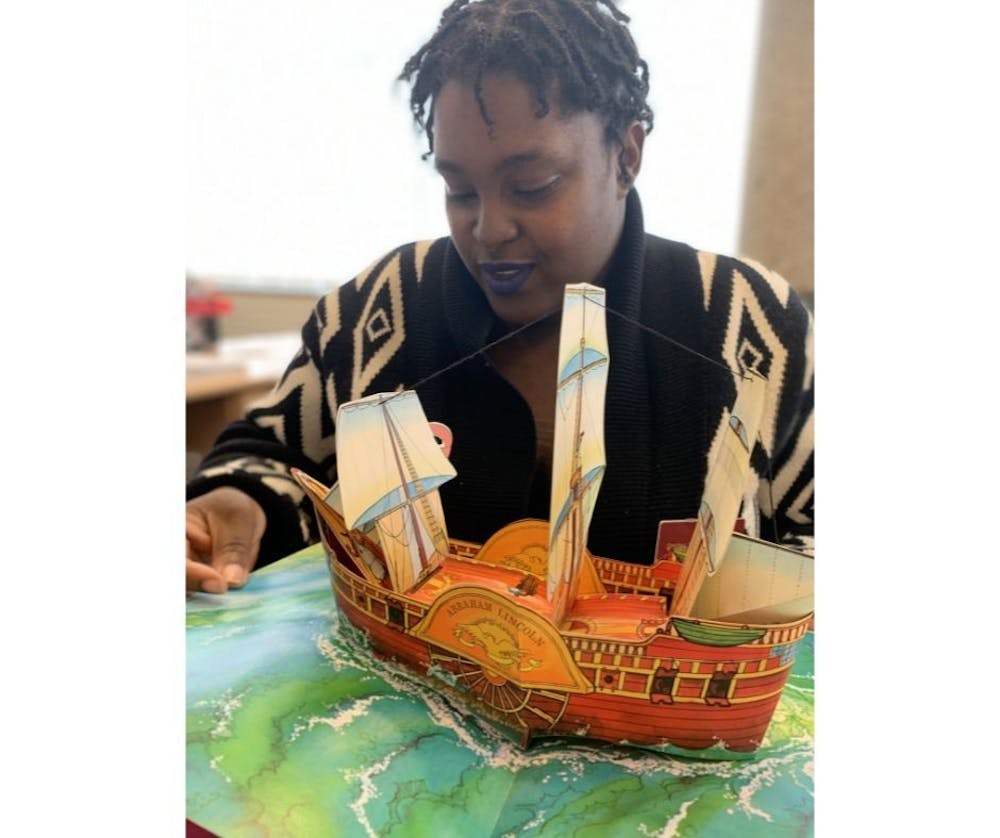Clarke Historical Library: A hidden gem

Senior Victoria Spencer unveils one of the hidden gems within Clarke Library, a pop-up book depicting the image of a ship named Abraham Lincoln, one of the books set to go on display as part of an upcoming museum attraction.
Many Central Michigan University students know that Park Library is the place to be when it comes to a quiet place to study, submerge themselves in books and explore cultures of the past and present.
Inside of the Park Library, however, sits a smaller, more closed-off library known as the Clarke Historical Library. The Clarke is around half of the size of the first floor of the Park Library, and is packed with items significant to the history of CMU and the world.
The Clarke is what is known as a "closed" library, meaning that while students may come in and look at materials, they can't check any out. Unlike a typical library, Clarke Library has a museum, a vault and hundreds of items that tell the story of what the world used to be like.
Central Michigan Life sat down with Victoria Spencer, a fifth-year senior and student employee for the Clarke to learn more about her experience and clear up some of the mystery surrounding this hidden gem on campus.
CM Life: Where did you get your start working for Clarke Library?
Spencer: I've been working at the Clarke for nearly five years. I started in the summer of my senior year of high school and worked closely with Bryan Whitledge, the archivist for University Digital Records. He was my supervisor at the time, and my position was mainly to digitize photos for a 3D model of Central Michigan's past into current times. I loved it so much that I wanted to come back.
What does Clarke offer to students?
The Clarke offers an array of materials that ranges from CMU history to the history of Michigan. We have special collections here, such as magazines from different time periods, the manuscripts of Michigan's past with the Ku Klux Klan, films of coal miners. There's so much more, too. It all depends on what you are looking for.
Is it true that there is a vault hidden inside of Clarke Library? What's inside of it?
Yes, this is true. While I don't know the exact measurements of it, it's the size of the entire extended study room, plus a little bit more. Inside of that room is the vault, which is about the size of a master bedroom. When you go inside of the vault, there's a special lock, and the lighting inside of the vault is very dim. It's got our most valuable items inside of it, one of those items being Abraham Lincoln's right hand, molded in brass. We've got paintings and posters, important historical items from the Native American reserve. The list goes on.
What is the most interesting item students can find when they come here? What is that item's backstory?
The most valuable book would be "Alice in Wonderland." The story is that the Europeans printed the original "Alice in Wonderland" book and distributed a set of 2,000 copies, but the artist who did the drawings for the novel felt that the drawings were too light, so he recalled all 2,000 of the books, including the book that Lewis Carroll gifted to Queen Victoria's daughter, Princess Beatrice. After the recall, books were darkened and rebound before being distributed back to the Europeans, and the light-colored books were sent to the United States. We have the book that was supposed to be given to Princess Beatrice. It has her seal on it.
Why should students visit Clarke Library? What sets it apart from the other libraries on and around campus?
The people are truly what set Clarke apart. It's their passion, their dedication, their years of servitude here. The Clarke helps students make connections. For students, we offer primary and secondary sources on such a large array of topics, from the KKK to Native Americans schools, where they were located and how they migrated. We have things here from the 17th century, and even a few items from as early as the 15th and 16th century. In a lot of ways we are a time capsule. We hold the memories of people from long before us, memories and pictures of their lives, and that's why students should come and immerse themselves in the culture that is Clarke Library.






